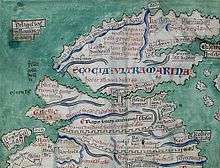Kingdom of Ce

The Kingdom of Ce (c. 1 - 900 AD)[1] was a legendary ancient Pictish kingdom in Scotland. The author of the Pictish Chronicle records that the kingdom was formed after the division of Alba among the seven sons of Cruithne. Ce was the first and eponymous king, and his reign lasted fifteen years.[2]:81 Some sources dispute this giving him a reign of eleven, twelve or twenty years.[3] The kingdom of Ce encompassed Banff, Buchan, and other areas of Aberdeenshire, such as a region now known as Mar.[4][5][6]
After the Roman period a number of Pictish kingdoms formed in the Eastern Scotland. Kingdom of Circind, that was further divided into the kingdoms of Fotla (Atholl), Fib (Fife) and Circind (county of Argus), bordered the kingdom of Ce in south. In the west around modern Inverness might have been the kingdom of Fidach. In the far north and in the Northern Isles was kingdom of Cat that later gave the name of the county of Caithness.[5]
The seven sons, or provinces, of Cruithne represent division within the Pictish nation. The kingdoms were ruled by hereditary chiefs (later known as mormaers). Irish sources sometimes refer to them as kings (ríg), although it was standard practice for all Irish rulers to be so named, with their actual rank denoted by an adjective. In times of weak central control, these local rulers would have certainly been more independent.[7]
The kingdom of Ce's name appears in titles of two Old Irish tales. The Ravaging of Bennachie is about the battle of Bennachie (Peak of Ce) and The Ravaging of the Plain of Ce by Galo son of Febal is about the destruction of the plain of Ce.[6][8] However, these works are, apart from their titles, lost. Plain of Ce might denote Urie's watershed.[8]
By the 6th century the Pictish people were divided into larger kingdoms of the Northern and Southern Picts.[5] Ce can be regarded as a frontier region between northern and southern Pictish influence.[8]
See also
References
- ↑ "Early Kingdoms of Scotland". 2013. Regnal Chronologies. Retrieved 18 May 2014.
- ↑ Chadwick, Hector Munro (1949). Early Scotland: The Picts, the Scots & the Welsh of Southern Scotland. CUP Archive.
- ↑ J. M. P. Calise (1 January 2002). Pictish Sourcebook: Documents of Medieval Legend and Dark Age History. Greenwood Publishing Group. p. 198. ISBN 978-0-313-32295-2.
- ↑ "Picts". Retrieved 29 December 2012.
- 1 2 3 Iain Forbes (30 November 2012). The Last of the Druids: The Mystery of the Pictish Symbol Stones. Amberley Publishing Limited. pp. 33–34. ISBN 978-1-4456-1215-7.
- 1 2 Benjamin Hudson (13 January 2014). The Picts. Wiley. p. 46. ISBN 978-1-118-59832-0.
- ↑ Stuart Piggott (30 October 2014). The Prehistoric Peoples of Scotland. Taylor & Francis. p. 159. ISBN 978-1-317-60044-2.
- 1 2 3 James Earle Fraser (2009). From Caledonia to Pictland: Scotland to 795. Edinburgh University Press. p. 109. ISBN 978-0-7486-1231-4.
Further reading
- William F Skene (January 2011). "Chapter VIII". The Four Ancient Books of Wales. Abela Publishing Ltd. pp. 83–100. ISBN 978-1-907256-92-9.
